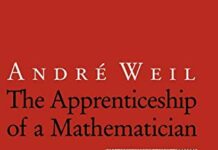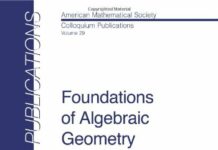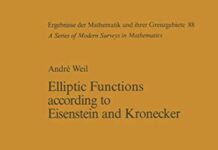
Ebook Info
- Published: 2007
- Number of pages: 375 pages
- Format: PDF
- File Size: 19.82 MB
- Authors: André Weil
Description
This book presents a historical overview of number theory. It examines texts that span some thirty-six centuries of arithmetical work, from an Old Babylonian tablet to Legendre’s Essai sur la Théorie des Nombres, written in 1798. Coverage employs a historical approach in the analysis of problems and evolving methods of number theory and their significance within mathematics. The book also takes the reader into the workshops of four major authors of modern number theory: Fermat, Euler, Lagrange and Legendre and presents a detailed and critical examination of their work.
User’s Reviews
Editorial Reviews: Review “The book makes a fascinating reading, permitting to perceive the birth of new ideas, and to understand why they should have been born… There are four chapters: Protohistory, Fermat and his correspondents, Euler and An age of transition: Lagrange and Legendre, and also several appendices, which introduce a modern point of view and provide proofs for many mentioned results. The book is strongly recommended to anybody interested in the history of mathematics and should be on the shelf of every number-theorist.” –Zentralblatt Math”As the author says, this is a historical treatment of that oldest and purest field of mathematics, the theory of numbers; his presentation is meticulous and scholarly… The volume under review…is a discursive, expository, leisurely peek over the shoulders of several great authors in number theory, a subject “conspicuous for the quality rather than for the number of its devotees; at the same time it is perhaps unique in the enthusiasm it has inspired”, as Professor Weil says in his preface.” –Mathematical ReviewsA very unusual book combining thorough philological exactness, keen observation, apt comments of the essential points, picturesque fantasy, enthusiastic love of the subject, and brilliant literary style: a romantic novel of documents. It is both number theory and its history in an inseparable oneness, helping us understand the very roots and the first big stage of progress of this discipline. The author, one of the most prominent number theorists…chose to give us a broad perspective of the birth of modern number theory.–Periodica Mathematica Hungaria From the Back Cover Number Theory or arithmetic, as some prefer to call it, is the oldest, purest, liveliest, most elementary yet sophisticated field of mathematics. It is no coincidence that the fundamental science of numbers has come to be known as the “Queen of Mathematics.” Indeed some of the most complex conventions of the mathematical mind have evolved from the study of basic problems of number theory.André Weil, one of the outstanding contributors to number theory, has written an historical exposition of this subject; his study examines texts that span roughly thirty-six centuries of arithmetical work ― from an Old Babylonian tablet, datable to the time of Hammurapi to Legendre’s Essai sur la Théorie des Nombres (1798). Motivated by a desire to present the substance of his field to the educated reader, Weil employs an historical approach in the analysis of problems and evolving methods of number theory and their significance within mathematics. In the course of his study Weil accompanies the reader into the workshops of four major authors of modern number theory (Fermat, Euler, Lagrange and Legendre) and there he conducts a detailed and critical examination of their work. Enriched by a broad coverage of intellectual history, Number Theory represents a major contribution to the understanding of our cultural heritage.—–A very unusual book combining thorough philological exactness, keen observation, apt comments of the essential points, picturesque fantasy, enthusiastic love of the subject, and brilliant literary style: a romantic novel of documents. It is both number theory and its history in an inseparable oneness, helping us understand the very roots and the first big stage of progress of this discipline. The author, one of the most prominent number theorists…chose to give us a broad perspective of the birth of modern number theory.–Periodica Mathematica HungariaThe volume under review…a discursive, expository, leisurely peek over the shoulders of several great authors in number theory…is perhaps unique in the enthusiasm it has inspired. –Mathematical Reviews
Reviews from Amazon users which were colected at the time this book was published on the website:
⭐This is the best book on the history of number theory that exists. I became acquainted with this book when doing a study on the history of Euler’s pentagonal number theorem. It is the an authoritative tour of the works of Fermat and Euler. It is not comprehensive for number theory before Fermat. For Greek number theory, the best book is the second edition of Thomas Heath, “Diophantus of Alexandria. A Study in the History of Greek Algebra”. For medieval Latin number theory, see Fibonacci,
⭐. For the theory of quadratic forms after Euler, the best book I’ve found is David A. Cox,
⭐.There are many bad books on the history of mathematics. A modern mathematician is seldom intimately familiar with the original writings of past mathematicians, while modern historians of science are seldom interested in meticulously working through old proofs and calculations and have a shibboleth against reworking old mathematics in modern notation. (This is a too-strong reaction by historians: Of course the best understanding of an ancient text is got by reading it in the original language without any tools developed after the text, but this demands too much from a lay reader, and I assert that some understanding can be won from reading a modernized version of an ancient argument.)Weil may be unique as a leading modern mathematician who is also fully at home reading the works of Fermat, Huygens, Euler, etc. He has digested their collected works, including their correspondence. Weil is not a number theorist with some interest in the history of their subject who reads secondary sources and then writes a book of folklore history (mentioning charming stories about how clever the young Gauss was at calculating, or about Euler calculating while blind). Because Weil has a deep mastery of the material, anyone studying the number theory of Fermat and Euler will not find anything better than this book. After Weil, the next best place for Fermat and Euler is in fact Heath, in the supplement to the second edition of his “Diophantus”.
⭐This item is of very great interest to me. It covers thoroughly, in brilliant exegesis, the whole history and mathematics of number theory from Hammurapi to Legendre at a level suitable for the general reader with an interest in number theory. The author was one of the pioneers in this field.
⭐Most people’s idea of Mathematics is classical Algebra, Euclidean geometry, and maybe Calculus. Few have ever heard of abstract algebra, topology, much less Number theory.There was a History of Number theory before Andre’s book – Oystein Ore’s book. Oystein’s book touches on some of the Euclid’s Elements a bit more. Both try and fail to keep from talking about Frederick Gauss’s congruence unification of all number theory before Gauss. Andre’s book not only relates some of the most ancient Number theory with modern, but he has “end of chapter” sections showing far more advanced connections into the 20th century. He points out that modern Diophantine analyses is absorbed in the Algebraic Geometry of varieties.As noted by another reviewer already, Andre initially tries to make this a textbook that someone without prior knowledge can dive into. The dream is quickly dashed. He references off much of the ancient as well as modern stuff; so, in the end, don’t worry if you don’t understand something. If you want a good introduction, and have some knowledge of basic group theory, Gauss’s congruence, Calculus, you have some mathematical literacy, i’d say go ahead and read it; acquaint yourself with the Number theory geography. You read around the equations, and even read the equations and mull over the mathematical ideas.Any piece of mathematics has a great historical interest – both for the regular human history and the technical history. Number theory is perhaps less told. Most Mathematicians would start with Euclid’s Elements at least. Maybe relate it to the Babylonian Mathematics before it(as Van Der Waerden does in his “Science Awakening”). Then, there’s Apollonius’s Conics and the collective works of Archimedes. There’s also Ptolemy’s Almagest. But, a technical history of Number theory is a bit messier. Diophantus collecitve works is a compilation, and not a deductive treatment. This doesn’t mean that the mathematics there is no less interesting. It generally takes a real Mathematician to put it all together.Andre Weil is farely well known for his Weil conjectures. Alexander Grothendieck became famous for proving his conjectures about Zeta functions and Algebraic Geometry.Andre was perhaps inspired by Dehn, who got a bunch of mathematicians together to try to see what mathematics could be found by reading the classics. Andre Weil was in attendance. This book was published much later. I guess Andre had lots of Mathematics to do, and wrote this towards the end of his creative Mathematics life.Reading this book should be exciting for anybody who’s been bit by the Mathematics bug. If you appreciate how mathematical concepts are just right idealizations/definition, and enjoy unified treatments that show those relations and create new exciting possibilities the old mathematics couldn’t get to, Number theory is exciting both intellectually, and even historically.All Mathematics is connected; so, one should read Number theory as any branch of Mathematics. Andre Weil, once again, shows many connections to invariant theory, abstract algebra, Algebraic Geometry, and Analyses.As previous reviewers noted, there’s also Sir Thomas Heath’s treatment of Diophantus. I’d point out John Stillwell’s “Elements of Number theory.” Although he makes many modern proofs and concepts of old concepts.
⭐This is a great book on number theory written by a master. The reader is led through the original discoveries ofof the Indian number theorists Brahmagupta and Bhaskara2 on solution of linear and quadratic Diophantineequations from the 6th to 12th century CE, then to the contributions to number theory of the great mathematicians Fermat, Euler, Lagrange and Legendre through a study of their original works. This is a great way to learn. Its a pitythat Gauss was not included. This is a brilliant book by a great mathematician and is strongly recommended. For me it is an indispensable book.
Keywords
Free Download Number Theory: An Approach Through History from Hammurapi to Legendre (Modern Birkhäuser Classics Series) in PDF format
Number Theory: An Approach Through History from Hammurapi to Legendre (Modern Birkhäuser Classics Series) PDF Free Download
Download Number Theory: An Approach Through History from Hammurapi to Legendre (Modern Birkhäuser Classics Series) 2007 PDF Free
Number Theory: An Approach Through History from Hammurapi to Legendre (Modern Birkhäuser Classics Series) 2007 PDF Free Download
Download Number Theory: An Approach Through History from Hammurapi to Legendre (Modern Birkhäuser Classics Series) PDF
Free Download Ebook Number Theory: An Approach Through History from Hammurapi to Legendre (Modern Birkhäuser Classics Series)



